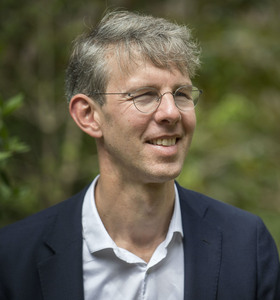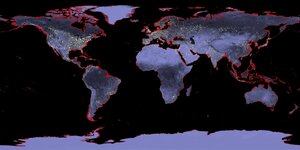A Q&A with IPCC coordinating lead author Maarten van Aalst

Professor Maarten van Aalst (Photo: Frans Nikkels / University of Twente)
About one month ago, the UN’s Intergovernmental Panel on Climate Change (IPCC) released a 37-page summary of its starkest findings on the state of our planet: the IPCC AR6 Synthesis Report. In short, it states that we are not only off-track from limiting global warming to a degree that will keep the world inhabitable as we know it, but we are also set to exceed this limit much sooner than expected.
Given the complexity of how systems interact inside our atmosphere, the climate risks rushing toward us are difficult to fully comprehend. But Maarten van Aalst, the Princess Margriet Chair in climate and disaster resilience at the University of Twente’s Faculty of Geo-Information Science and Earth Observation, has spent decades researching this topic and maintains that there are still realistic ways we can mitigate and adapt to these dangerous predictions. Serving as a lead coordinating author for the IPCC, he shines light on plausible pathways for resiliency and hope, both in the report and here in an interview he gave with UNU-MERIT.
The findings of the IPCC reports coming out over the past years have been increasingly bleak. How does this affect you and your work?
Late last year, ahead of the UN climate negotiations in Egypt, UN Secretary General António Guterres said that “we are on a highway to climate hell with our foot still on the accelerator”. I do think we need to change course, but this might be a bit too harsh. A lot is still possible, things just needs to happen faster than we’re doing them right now.
To me, there’s a strong message of hope and a call to make our science known, raising the level of awareness of the edge between science, policy and practice. We need to make sure science really activates not just policy debate, but real changes in society around the world.
Has the rapid escalation of climate change we’ve seen in recent years surprised you, or did you expect the slope to be this steep?
Many of the risks are coming at us faster than I had expected. We’re seeing things happening now that I had imagined would happen several decades down the line.
I would also say the risks turn out to be bigger than we had anticipated partly because we need to recognise that much of our science is still too linear, and we’re dealing with a very complex system. We have to translate what’s happening in the atmosphere and what’s happening in the oceans to what’s happening in human societies, and then see how all the different types of risks add up to much more than the sum of their parts.
Also, we have to see how our responses to some of the risks are constraining how we deal with other risks, or even generating new risks.
Could you give an example of such a trade-off in climate risks?
Here in the Netherlands, we were initially thinking of climate change as causing a gradual rise in sea levels and that we’d add a few centimeters to our coastal protection. Then we realized there would also be more water coming down through the rivers flowing into our delta, and raising sea walls and river dykes would not be enough. So we created a programme – called ‘Room for the River’ – which allowed higher peaks of water to flow down in a more gradual way. It’s been celebrated as a type of transformational adaptation, different from classical approaches.
We did have a rise in the sea level and more extreme river runoff due to more extreme heavy rainfall events, so we can see that our investments paid off, the programme worked. However, in the past couple of summers, we’ve suddenly had long periods of drought (and heat). This has made us realise that we became very good at getting rid of water, but now we’re not so good at retaining it. So this is a classic example of a trade-off.
Another example would be the fact that we’re counting on biofuel production as a way of producing renewable energy. But if you look at how much biofuel we will need if we don’t shift our current energy consumption patterns and also generate other types of renewable energy such as solar and wind, then biofuel production is going to take up so much land that it will compete with food security, which itself is already under pressure in a changing climate. These sorts of compounding effects continue to surprise the most.
You’ve just mentioned examples of how we can and should be adapting to climate change. How, at this point in time, do you believe we should be balancing mitigation of climate change with adaptation to its realities?
Twenty years ago, people were saying that if you start talking about adaptation, it means you’re undercutting mitigation. But it’s certainly no longer an either-or situation, which the Paris Agreement on Climate Change acknowledged in its three goals on mitigation, adaptation and solidarity – the latter meaning that the world needs to deal with this together and also to recognise that some countries have a higher burden to help others.
We need to adapt. Whether it’s people with pre-existing diseases or the elderly in Western societies hit by heatwaves, or poorer countries that have contributed the least to these problems but are hit the hardest, we need to be coping with the rising extremes and disasters. But this also illustrates how much it’s needed to mitigate and reduce emissions faster in order to not let things get further out of hand.
One new insight from the IPCC AR6 report is that there are limits to adaptation. Could you expand on this?
So there’s a lot of evidence in the IPCC report about how we can be more effective – anticipating changing extremes, for instance, and doing better on both shorter and longer time scales to reduce those impacts. But we’re also seeing a number of cases where there will be no adaptation possible and that things will get lost.
The most obvious examples are, of course, things where we do not have a lot of leeway for human intervention. If temperatures rise beyond 1.5 degrees Celsius, we know that we will lose pretty much all of the coral reefs in the world. There’s no stopping that with human interventions. On the human side would be the loss of small islands and atolls that are very low-lying, which are difficult to defend against climate change, and the potential loss of cultures on those islands too.
What types of policies should developed countries be producing in order to help more vulnerable areas of the planet?
I’d again go back to the triplet of actions laid out in the Paris Agreement: mitigation, adaptation and solidarity. We all need to reduce emissions on a global level to avoid worsening problems, but we also need to cope with the risks we’re already facing. This is where we can have good news, with interventions that have win-wins with other development objectives.
There are things that can be done that spur economic growth that make you more vulnerable to changing risks, but there are also ways you can work on both fronts. For instance, tourism development in some of these small island states has led to coastal infrastructure that reduces natural defense systems, such as mangroves and coral reefs. But there are also places like the Seychelles that have invested in ecotourism, establishing ways of protecting nature alongside a more sustainable tourism model that inherently must be slightly more expensive. This brings in higher revenue per tourist and also means fewer people also travel to those places, which also helps protect the ecosystems.
These sorts of considerations need to be woven into development trajectories.
What is your advice for students and young people who want to go into climate policy- or decision-making careers?
Well, first of all, I think it’s a good choice. We need all the brains we can get in this field. It’s one of the places where science, policy and practice merge the most in addressing some of the most transformational changes the world needs in the coming decades – so it’s a very exciting field.
Second, I would stress that the old sectoral way of dividing up fields of science or areas of responsibility and government will no longer work. We must be interdisciplinary, and we need students that are able to combine different types of knowledge to talk across different interests, actors and areas of expertise.
Lastly, we need a great variety of areas of expertise: from people with deep technical skills to experts in communication, to artists, to lawyers, to managers. Almost everyone has something to contribute.
ANY COMMENTS?
NOTA BENE
The opinions expressed here do not necessarily reflect the views of UNU.
MEDIA CREDITS
Photo by Frans Nikkels FN20190524 / University of Twente; Renzo D’souza on Unsplash; NASA





